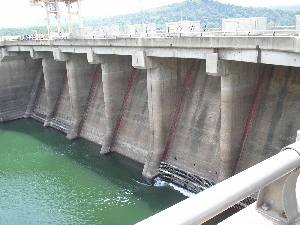The power sector has been dissected by many as experts attempt to diagnose the main challenges plaguing the sector and find the appropriate remedy.
The sector faces enormous operational challenges, below-par tariff and significant system losses have come under intense scrutiny in recent times.
While the public is dissatisfied with the perennial power outages, Independent Power Producers (IPPs) and the Volta River Authority (VRA) are unhappy about one member in the power production, supply and distribution chain -- the Electricity Company of Ghana (ECG).
The inability of ECG to fully pay for the amount of power it receives from power producers due to their weak tariff collection regime has resulted in power producers piling on debts as they fight the odds to keep up with demand.
Current power generation at peak is about 1,770MW while demand is about 1,850MW -- leaving a deficit of about 80MW.
Out of the country’s total installed capacity of 2,846.5MW, the VRA generates about 75 percent of it from hydro and thermal sources. The mix includes VRA hydro, 47 percent; VRA thermal, 36 percent; VRA solar generation, 0.1 percent; IPP thermal generation 12 percent; and Bui hydro, 5 percent.
Kofi Ellis, the Business Development Manager of the VRA in an interview with the B&FT said: “The ECG angle is making it difficult to refinance everybody in the chain. The only way we can solve this problem is for government to step in and give money to support the shortfall in production. But, unfortunately, government doesn’t have the money. So now VRA has to go to private banks and try looking for funding to purchase the most important commodity -- crude oil -- to sustain production so that we don’t end up increasing the load-shedding activity.
“This is the case: that because of the money VRA is not getting from ECG, VRA goes to private banks and borrows the money at a high-interest rate -- which comes onto its balance sheet. VRA is piling on debts because of the situation we find ourselves in.”
The largest power producer, the VRA, normally monitors its cost of production on weekly basis, mainly due to the fact that its production-mix changes with time. The Authority’s cost of production is currently about 26 pesewas per kilowatt hour.
It is, however, allowed by the Public Utilities and Regulatory Commission (PURC) to charge a tariff of about 14 pesewas per kilowatt hour for power it sells to ECG and Northern Electricity Department of the VRA.
However, the weighted average tariff per kilowatt hour for the Authority is about 20 pesewas per kilowatt hour. This is attributable to the fact that the Authority sells power directly to some major mining companies for a slightly higher tariff per kilowatt hour.
Mr. Ellis added: “If your total cost is about 26 pesewas, then you can say that we are dragging by some 6 pesewas. A 6 pesewas difference, some would say, shouldn’t drag the company into debt.
“But the difficulty is that the 1,600MW power VRA sells to ECG expecting payment at a rate of 14 pesewas per kilowatt-hour, the Authority gets half or slightly less than half of its expected tariff. So, indirectly, VRA is selling the 1,600MW at 7pesewas because it is paid half. So the weighted average, if you calculate with 7 pesewas, you get a number that is woefully low.”
He said: “Some of the power is lost by technical means. The amount ECG collects, it has to pay the IPPs first and what is left is virtually shared between us and GRIDCo. So at the end of day, the physical liquidity to run the organisation is very bad.”
He said banks are now reluctant to issue Letters of Credit (LOC) due to the Authority’s debt servicing history.
“We haven’t paid the banks what they expect because we haven’t had enough receipts. So going back to them for another loan facility to purchase the next crude is a problem. So the crude oil supplier brings the crude, you’ve ordered it; it stays at the port and the supplier tells you ‘until I see a letter of credit I will not discharge it’. Mind you, for every day that it stays at the port, VRA pays demurrage and it adds to VRA’s cost.
“This makes the whole design so complex and so confusing. How long can we sustain this kind of business,” he questioned.
The poor inflow of water into the Akosombo, Bui and Kpong Dams for hydro power generation means that the Authority must increase it thermal power generation to augment the hydro power generated, but it cannot keep up with the about-US$55million required to purchase crude every three weeks.
“Now that, unfortunately for us, the water level in Akosombo is meeting expectation, it means that we will need more thermal energy to support. How are we going to fuel the thermal energy? With what money; coming from where?” Mr. Elis quizzed.
The Akosombo Dam is expected to record poor inflow of water in the next two years, which will lead to a shortfall in electricity generated from hydro, an informed analysis of water inflow into the dam has shown.
The minimum operating water level for the Akosombo Dam is pegged at 240 feet. However, the water inflow into the lake has recorded a consistent reduction in year-end inflow since 2010. The water level in December 2010 was 275.40ft; 271.97ft in 2011; 268.50ft in 2012; 257.80ft in 2013.
For the first quarter of 2014, the water level has continued to dwindle. January recorded an inflow of 256ft; 254ft in February; and 252 ft in March.The water level in the dam now hovers around 243 feet --just 3feet above the minimum operating level of 240.00 feet
The ECG quagmire is expected to be the focal point of action for the second compact of the Millennium Challenge Corporation’s (MCC) latest grant.
The agreement between Ghana and the United States to access the grant, worth US$498million under the second compact of the Millennium Challenge Account, was signed on August 5 this year. The funds will be used for improvement of power distribution in the country.
Ghana is hopeful of accessing the first tranche of funds by mid-2015. Under the second compact, an initial investment of up to US$149.6million will be provided to put the country’s main distribution company, the Electricity Company of Ghana (ECG), on a path to sustainability.
It will also help the ECG meet existing and future demand for electricity by improving oversight and management, and upgrading infrastructure to reduce inefficiencies and improve service.
The grant will be targeted at enhancing the distribution system, effecting institutional changes, and creating a Power Park to boost energy consumption.
The only thing that can save the situation, Ellis argues, is to reduce our crude imports. “That is why every day we keep monitoring when Ghana Gas Company will start releasing gas. If they release only 60 million standard cubic feet per day, we will take away two machines that are running on crude oil and run them on gas."
The country’s gas processing plant has taken longer than expected. The project, which is to process 150 million Standard Cubic Feet of raw gas per day from oilfields off-shore cape Three Points, is now scheduled to be completed by end of the year.
“Each turbine consumes 5,000 barrels of crude in a day. So two machines mean 10,000 barrels of crude per day. One cargo of crude is 450,000 barrels. So you can save yourself a number of days of crude. The coming on-stream of gas will mean that we cut down on the amount spent on importing fuel,” he said.
Business News of Tuesday, 26 August 2014
Source: BFT













